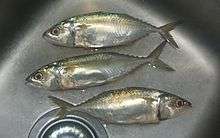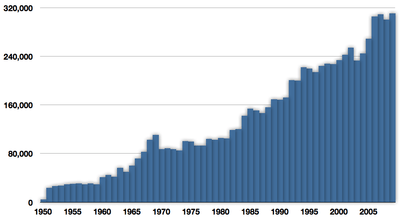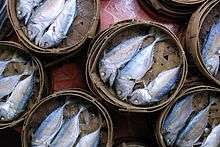Short mackerel
| Short mackerel | |
|---|---|
 | |
| Scientific classification | |
| Kingdom: | Animalia |
| Phylum: | Chordata |
| Class: | Actinopterygii |
| Order: | Perciformes |
| Family: | Scombridae |
| Tribe: | Scombrini |
| Genus: | Rastrelliger |
| Species: | R. brachysoma |
| Binomial name | |
| Rastrelliger brachysoma (Bleeker, 1851) | |
| Synonyms | |
| |
The short mackerel or shortbodied mackerel (Rastrelliger brachysoma) is a species of mackerel in the family Scombridae.[2] Its habitat is the shallow waters of Southeast Asia and Melanesia, feeding mainly on small zooplankton. It is of major importance in the fisheries industry.
Description
The short mackerel can attain a maximum length of 34.5 cm, but lengths of around 20 cm are more common. It reaches maturity at a length of about 17 cm. The species has the typical appearance of a medium-sized mackerel and is of silver colour. The snout is somewhat pointed.[3]
Ecology
The short mackerel is pelagic but prefers to feed in estuarine habitats, at surface temperatures of 20–30 °C (68–86 °F). It is a plankton feeder. The spawning season can extend from March to September, with individual populations spawning in batches.[3]
Fisheries
The species is of major commercial importance, and is caught by various methods ranging from gillnetting to dynamite fishing.[1]

As food
In Thailand

Pla thu (Thai: ปลาทู) is a very important fish in Thai cuisine, where it is sold in the market with the head bent downwards, which gives it a characteristic shape. Pla thu is typically fried and eaten with nam phrik kapi, boiled and raw vegetables and leafy greens, as well as pieces of cha-om omelette, but it is essential in many other preparations.[4] The name pla thu is sometimes also applied to the Indian mackerel (Rastrelliger kanagurta), which is prepared in the same way.
In the traditional way of processing the pla thu for preservation, the gills are removed and the head of the fish is bent downwards forcefully towards the belly by breaking its backbone. This is done to allow three fishes to fit into a small open-work bamboo basket of a predetermined size. Once in the baskets, the fish are boiled for a few minutes in large basins of sea-water with salt added at 1 kg (2.2 lb) of salt for every 4 litres (0.88 imp gal; 1.1 US gal) of water. In Thai cuisine, the thus processed pla thu is most often eaten fried in combination with nam phrik kapi, a spicy dip made with shrimp paste, dried prawns, lime juice, fish sauce, and the small pea eggplant, with rice and steamed, raw, or fried vegetables.[5]
The pla thu prepared in this way will keep for a very long time in the refrigerator. In former times, it kept for about two weeks without refrigeration as long as it was boiled for a few minutes every two days. In this manner, this sea fish could reach many places in interior Thailand, like the Chiang Mai area in the far north and even remote places in Isan, where it is much appreciated.[6]
Fresh pla thu is commonly used to make soups such as tom yam pla thu. This fish is so popular in Thai culture that the Samut Songkhram F.C. has a pla thu in its emblem.
Already in 1870 CE, Anna Leonowens describes the importance of this fish for Thailand in her book The English Governess at the Siamese Court: "The stream is rich in fish of excellent quality and flavour, such as is found in most of the great rivers of Asia; and is especially noted for its plathu, a kind of sardine, so abundant and cheap that it forms a common seasoning to the labourer's bowl of rice. The Siamese are experts in modes of drying and salting fish of all kinds, and large quantities are exported annually to Java, Sumatra, Malacca, and China".[7]
The innards of this mackerel are one of the main ingredients of tai pla sauce, used in the preparation of the well-known kaeng tai pla curry.[8]
In other countries
This type of mackerel is also very important in the cuisine of other regions of Southeast Asia, such as Cambodia, the Philippines (where it is the most commercially important variety of mackerel), and Malaysia.
References
- 1 2 Collette, B., Di Natale, A., Fox, W., Juan Jorda, M. & Nelson, R. (2011). "'". IUCN Red List of Threatened Species. IUCN. 2011: e.T170318A6745895. Retrieved 2 December 2015.
- ↑ "Rastrelliger brachysoma (Bleeker, 1851)". Integrated Taxonomic Information System. Retrieved 5 August 2011.
- 1 2 Froese, Rainer and Pauly, Daniel, eds. (2015). "Rastrelliger brachysoma" in FishBase. 12 2015 version.
- ↑ Holy Mackerel
- ↑ Pla thu is a very Thai fish
- ↑ Asia-Pacific Fishery Commission
- ↑ "ScholarBank@NUS: Terms of Use" (PDF). Scholarbank.nus.edu.sg. 2010-04-12. Retrieved 2012-11-18.
- ↑ Akkasit Jongjareonrak et al. Antioxidant activity of fermented fish viscera (Tai-Pla) from short-bodied mackerel, Faculty of Agro-Industry, Prince of Songkla University, Hat Yai, Songkhla, 90112 Thailand
External links
| Wikimedia Commons has media related to Rastrelliger brachysoma. |
- Rastrelliger brachysoma (Bleeker, 1851) FAO, Species Fact Sheet. Retrieved 11 March 2012.
- Problems with the Development of Fisheries in Thailand
- A video of pla thu being fried
- Chu chi pla thu sod - Picture


